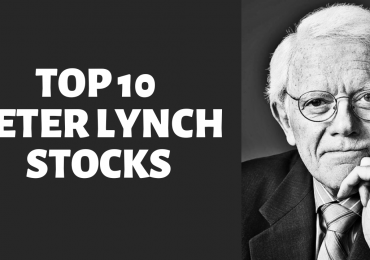Every other issue of The Validea Hot List newsletter examines in detail one of John Reese’s computerized Guru Strategies. This latest issue looks at the Peter Lynch-inspired strategy, which has averaged annual returns of 10.0% since its July 2003 inception vs. 6.0% for the S&P 500. Below is an excerpt from the newsletter, along with several top-scoring stock ideas from the Lynch-based investment strategy.
Taken from the March 28, 2014 issue of The Validea Hot List
Guru Spotlight: Peter Lynch
Choosing the greatest fund manager of all-time is a tough task. John Templeton, Benjamin Graham, John Neff — a number of investors have put up the types of long-term track records that make it difficult to pick just one who was “The Greatest”.
If you were to rank Peter Lynch at the top of the list, however, you’d probably find few would disagree with you. During his 13-year tenure as the head of Fidelity Investments’ Magellan Fund, Lynch produced a 29.2 percent average annual return — nearly twice the 15.8 percent return that the S&P 500 posted during the same period. According to Barron’s, over the last five years of Lynch’s tenure, Magellan beat 99.5 percent of all other funds. If those numbers aren’t impressive enough, try this one: If you’d invested $10,000 in Magellan the day Lynch took the helm, you would have had $280,000 on the day he retired 13 years later.
Just like investors who entrusted him with their money, I, too, owe a special debt of gratitude to Lynch. When I was trying to find my way in the stock market many years ago, Lynch’s book One Up On Wall Street was a big part of what put me on the right track. Lynch didn’t use complicated schemes or highbrow financial language in giving investment advice; he focused on the basics, and his common sense approach and layman-friendly writing style resonated not only with me but with amateur and professional investors all over, as evidenced by its best-seller status. The wisdom of Lynch’s approach so impressed me that I decided to try to computerize the method, the first step I took toward developing my Guru Strategy computer models.
Just what was it about Lynch’s approach that made him so incredibly successful? Interestingly, a big part of his approach involved something that is not at all exclusive to being a renowned professional fund manager: He invested in what he knew. Lynch believed that if you personally know something positive about a stock — you buy the company’s products, like its marketing, etc. — you can get a beat on successful businesses before professional investors get around to them. In fact, one of the things that led him to one of his most successful investments — undergarment manufacturer Hanes — was his wife’s affinity for the company’s new pantyhose years ago.
But while his “buy-what-you-know” advice has gained a lot of attention over the years, that part of his approach was only a starting point for Lynch. What his strategy really focused on was fundamentals — that’s why I was able to computerize it — and the most important fundamental he looked at was one whose use he pioneered: the P/E/Growth ratio.
The P/E/Growth ratio, or “PEG”, divides a stock’s price/earnings ratio by its historical growth rate. The theory behind this was relatively simple: The faster a company was growing, the more you should be willing to pay for its stock. To Lynch, PEGs below 1.0 were signs of growth stocks selling on the cheap; PEGs below 0.5 really indicated that a growth stock was a bargain.
To show how the P/E/G can be more useful than the P/E ratio, Lynch has cited Wal-Mart, America’s largest retailer. In his book “One Up On Wall Street”, he notes that Wal-Mart’s P/E was rarely below 20 during its three-decade rise. Its growth rate, however was consistently in the 25 to 30 percent range, generating huge profits for shareholders despite the P/E ratio not being particularly low. That also proved another one of Lynch’s tenets: that a good company can grow for decades before earnings level off.
The PEG wasn’t the only abbreviation Lynch popularized within the stock market lexicon. His strategy is often used as a primary example of “GARP” — Growth At A Reasonable Price — investing, which blends growth and value tenets. While some categorize Lynch as a growth investor because his favorite type of stocks were “fast-growers” — those growing earnings per share at an annual rate of at least 20 percent — his use of PEG as a way to make sure he wasn’t paying too much for growth really makes him a hybrid growth-value investor.
One Size Doesn’t Fit All
One aspect of Lynch’s approach that makes it different from those of other gurus I follow is his practice of evaluating different categories of stocks with different variables. His favorite category, as I noted, was “fast-growers”. These companies were growing earnings at a rate of 20 to 50 percent per year. (Lynch didn’t want growth rates above 50 percent, because it was unlikely companies could sustain such high growth rates over the long term).
The other two main categories of stocks Lynch examined in his writings were “stalwarts” and “slow-growers”. Stalwarts are large, steady firms that have multi-billion-dollar sales and moderate growth rates (between 10 and 20 percent). These are usually firms you know well — Wal-Mart and IBM are current examples of “stalwarts” based on that definition. Their size and stability usually make them good stocks to have if the market hits a downturn, so Lynch typically kept some of them in his portfolio.
“Slow-growers”, meanwhile, are firms with higher sales that are growing EPS at an annual rate below 10 percent. These are the types of stocks you invest in primarily for their high dividend yields.
One way Lynch treated slow-growers and stalwarts differently from fast-growers involved the PEG ratio. Because slow-growers and stalwarts tend to offer strong dividend yields, Lynch adjusted their PEG calculations to include dividend yield. For example, consider a stock that is selling for $30, and has a P/E ratio of 10, EPS growth of 12 percent, and a 3 percent yield. To find the PEG, you’d divide the P/E (10) by the total of the growth rate and yield (12+3=15). That gives you 10/15=0.67, which, being under 1.0, indicates that the stock is indeed a good value.
Another difference: For slow-growers, Lynch wanted a high yield, and the model I base on his approach requires dividend yield to be higher than the S&P average and greater than 3 percent.
Beyond The PEG
The PEG wasn’t the only variable Lynch applied to all stocks. For fast-growers, stalwarts, and slow-growers alike, he also looked at the inventory/sales ratio, which my Lynch-based model wants to be declining, and the debt/equity ratio, which should be below 80%. (For financial companies, it uses the equity/assets ratio and return on assets rates rather than the debt/equity ratio, since financials typically have to carry a lot of debt as a part of their business.)
The final part of the Lynch strategy includes two bonus categories: free cash flow/price ratio and net cash/price ratio. Lynch loved it when a stock had a free cash flow/price ratio greater than 35 percent, or a net cash/price ratio over 30 percent. (Lynch defined net cash as cash and marketable securities minus long term debt). Failing these tests doesn’t hurt a stock, however, since these are only bonus criteria.
A Market-Beater
Over the long term my Lynch-inspired model has had its ups and downs, but if you’ve stuck with it, it’s paid off. In 2013 it was a particularly strong performer, with my 10-stock Lynch-based portfolio gaining 68.6% to more than double the S&P 500. Overall since I started tracking it in July 2003, the portfolio has averaged annualized returns of 10.0%, easily beating the 6.0% annualized return for the S&P 500 (all performance figures are through March 25). The 20-stock Lynch-inspired portfolio I track has been one of my best performers, gaining 15.4% annualized over that period.
Here’s a look at the stocks that currently make up my 10-stock Lynch-based portfolio:
Silicon Motion Technology Corporation (SIMO)
Cisco Systems, Inc. (CSCO)
Celestica Inc. (CLS)
Axa SA (AXAHY)
Banco Macro SA (BMA)
NetApp, Inc. (NTAP)
USANA Health Sciences, Inc (USNA)
CNOOC Limited (CEO)
Ecopetrol SA (EC)
Smith & Wesson Holding Corporation (SWHC)








